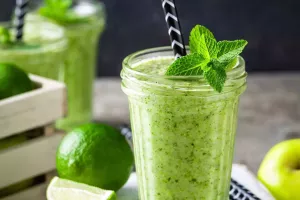It's time to fall in love with cherries. These cute little red fruits derive their name from the Turkish town of Cerasus. And not surprisingly, Turkey, the country that named cherries, is the largest grower of cherries in the world. They’re perfectly sweet and purely delightful, especially when baked into a fresh cherry pie. In celebration of National Cherry Month, we put together 10 wildest facts about this beloved stone fruit.
1. We’ve been eating them since the stone age.
Archaeologists have discovered fossilized cherry pits in prehistoric caves throughout Europe and Asia. The earliest written mention of cherries comes from the Greek author Theophrastus, who inventoried the fruit in his History of Plants in 300 BCE. Around the same time, Diphilus of Siphnos, a Greek author and physician, wrote of cherries’ usefulness as a diuretic.
2. The average cherry tree has 7,000 cherries.
That’s right. A single tree can yield enough cherries to make 28 pies. (Or at least a few of our favorite cherry desserts!)
3. A cherry tree can be harvested in seven seconds.
Thanks to the introduction of mechanical tree shakers, the laborious process of hand-picking cherries now takes a mere seven seconds per tree. Efficiency has its price, though. Because the machine is so intense, it shortens a tree’s life by seven years.
4. Japanese cherry blossom trees don’t produce fruit.
Despite the name, cherry trees don’t always produce cherries. Most varieties are ornamental, not fruit-bearing, trees. So if you go to the famous National Cherry Blossom Festival in Washington, D.C., don’t expect to pick any cherries while you’re there.
5. There are two main types of cherries: sweet and tart.
Sweet cherries are mostly grown in California, Washington and Oregon, and tart cherries are mostly grown in Michigan and Wisconsin. The most common type of sweet cherry is the Bing, followed by Lambert and gold-toned Rainier. Sweet cherries are usually eaten fresh, as a fun snack. The most common type of tart cherry is the Montmorency. Tart cherries are used in baking because they hold their shape better than their sweeter cousins. The tartness also allows bakers to adjust the sweetness level until it’s just right. The next time you get hold of some fresh tart cherries, make this cherry streusel tart.
6. Door County, Wisconsin, is nicknamed Cherryland USA.
Door County was once the No. 1 grower of cherries in the U.S. During the 1950s, it produced 95 percent of the nation’s tart cherries, with more than 1 million cherry trees. Today, there are only 2,500 acres of cherry orchards in the county (that’s still a lot!). Door County residents pride themselves on their cherries. Go to any restaurant and you’ll likely find a cherry special on the menu. (Cinnamon Roll Cherry Cobbler, anyone?)
7. Traverse City, Michigan, is known as the Cherry Capital of the World.
Today, Michigan is the big producer in the cherry-growing business, with more than 30,000 acres of cherry trees. In the Traverse City region alone, a whopping 4 million trees produce 150 to 200 million pounds of tart cherries annually. Traverse City’s annual National Cherry Festival started in the 1920s as an informal “blessing of the blossoms” ceremony. Now it’s a weeklong festival attended by people from all over the world.
8. The Midwest has ideal weather conditions for growing tart cherries.
It’s no coincidence that Michigan and Wisconsin produce so many cherries. The land off Lake Michigan is ideal for cherry trees. Weather conditions prevent early frost, and the light wind helps pollinate the trees. Alkaline soil and shallow limestone deposits are also beneficial.
9. Michigan hosts official cherry pit-spitting contests-and they’re pretty awesome.
Think you’ve got skill in spitting a cherry pit? There’s a place you can prove it. Eau Claire, Michigan-known as the Cherry Pit Spitting Capital of the World-hosts the International Cherry Pit-Spitting Championship every year. The world record for cherry stone spitting is a whopping 93 feet 6.5 inches. Talk about impressive! When I tried my hand at pit spitting, mine only reached 17 feet.
10. This ruby red fruit delivers some health benefits, too.
Cherries are jam-packed with antioxidants, vitamins and minerals that are good for your health. To sweeten the deal, they’re low in calories, too! Pack some in your lunch bag for a guilt-free snack.


